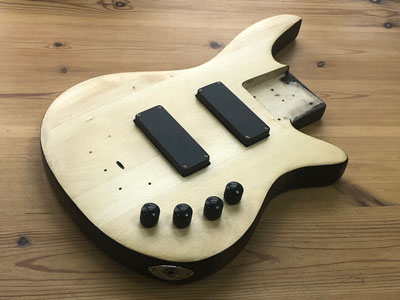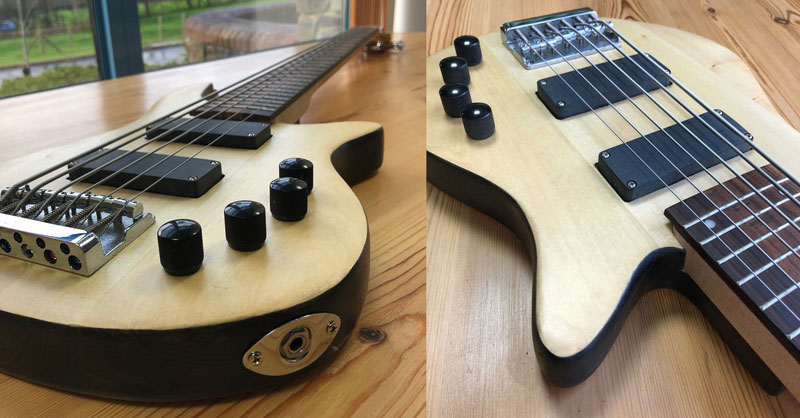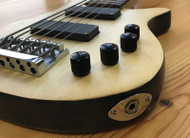How to Finish a Guitar with Osmo Oil
Posted by Celtic Sustainables on 20th Mar 2020
Our Ian been a bass player for longer than he cares to remember and always wanted to build and paint his own guitar. So when his friend and second-hand guitar shop owner recently advertised a selection of project guitars, he couldn’t help but notice an interesting six string bass of unknown origin that needed a bit of TLC. At a bargain price he decided it was worth a punt, so he gave him a call and reserved it for further inspection.
We think it turned out pretty well, wouldn't you agree! Find out how he created the look below ...


"Bearing no manufacturers name or serial number, I’m guessing it was probably a kit guitar that had been ‘put together’ by a previous owner. Devoid of any aesthetic improvements, other than an attempt at some pyrography, I presumed the builder got fed up mid build and had decided to put the project to one side or just play it as it was. When I took ownership, it had 1 string a very grubby bare wood finish and a tone control with infinite adjustment! Oh wait, it isn’t actually wired into the circuit. That’s interesting!
"The first job was to strip it down to the individual components and access the usability of the parts. Everything looked serviceable so I broke out the random orbital sander and got to work ridding the world of Piccasso’s perfunctory pyrography efforts. At the same time, I decided to attempt some minor body reshaping. Not too much fettling though, just enough to smooth the edges and make it a bit more comfortable to play.
"I don’t have a record of what the body is made of, however a likely candidate and common wood used for mass produced guitar bodies is ‘Bass Wood’, also known as Limewood or Linden here in the UK. It’s a nice wood to work with but it’s quite soft, so I presume the manufacturers assumption was a hard paint finish would be used to give it some protection.
How to Paint a Guitar
"I did a quick search on Youtube for 'how to paint a guitar' and it soon became apparent that the common method of finishing is to spray the guitar with the type of paints and lacquers used in the Auto industry.
"Not wanting to spray nitrocellulose lacquer or similarly toxic paints in my house, I needed an environmentally and lung friendly alternative. A further of online research turned up a couple of videos of oil being used to get a natural finish on a guitar, which looked really good.
"Step up to the podium Osmo Polyx Oil 3032 clear satin. Not only is it a low odour and non-toxic oil based alternative, but it also has a tough finish developed to protect wooden floors and worktops, so I figured it should offer ample protection for my guitar.
"I couldn’t decide if I wanted to stain the almost white wood before finishing, so as well as the Polyx Oil, I grabbed a sample of Osmo wood wax finish in black. From the sample board in the shop I could see that a single coat gives a lovely highlighted effect to the grain.

"I tested the black stain on the top and sides of the guitar body which made the grain look amazing, but comparing before and after photos, I decided I preferred the way the pale colour of the wood contrasted with the black Pickups and the dark wood fretboard. So, deciding to sand if off and start again, I grabbed by trusty orbital sander and went to work on the top. As I removed the stained layer of wood, I noticed that there was a lovely line developing between the top and the still stained edges so decided to stop there and make it a feature. Conscious that very fine sandpaper would close the grain and stop the oil penetrating, I worked down to a 150 grit sandpaper. Happy with the resultant finish I decided to stop there.
"Next up, Osmo 3032 - Satin Polyx oil. As with most clear finishes, I knew it would to darken the wood colour slightly, but the wood was so pale, that it wasn’t an issue for me, otherwise I could have gone for the Osmo 3044 - Polyx oil Raw which contains a tiny amount of white pigment to counteract the darkening effect of the oil. I applied the 3032 with a lint free cloth over the entire surface, including the black stained edge, working it well into the grain in a circular motion). I left it in a warm room for about an hour and then working along the grain I buffed with a clean cloth to remove any excess product. The key with Osmo products is thin coats. I repeated the process 3 more times leaving at least 12 hours between coats. As an experiment, I purposely over-applied the last coat and left it for a couple of hours before buffing. It took a little bit more work to remove the excess, but I was rewarded with a deep satin finish which looked particularly good over the stained edges.
"Happy with the finish on the body, I treated the neck and headstock in the same way, applying just 2 coats to the neck to avoid any stickiness and I just one coat on the fingerboard to enhance the dark wood.

"All in all, I’m very pleased with the finish, lots of people have commented on how good it looks, so I guess it’s just a case of seeing how it holds up to use. Another benefit of the Osmo products is that they are easy to refinish. Should it be necessary in the future, a wipe down of the surface and reapplication of the oil is all that is needed. Osmo also produce a Liquid Wax Cleaner that applies a thin layer of wax as it cleans which will extend the life of the finish even further."
Find out more about Polyx oil and other great Osmo products on our website.

